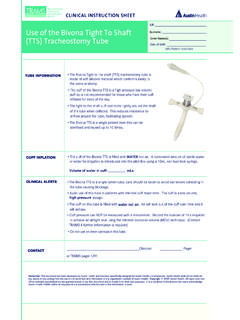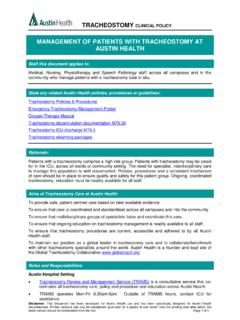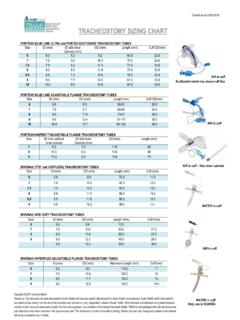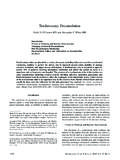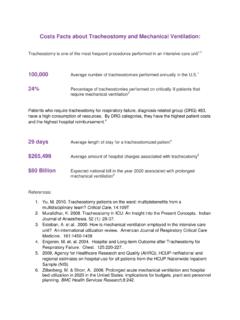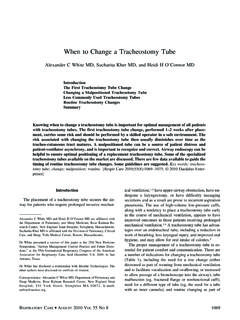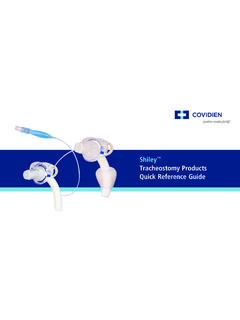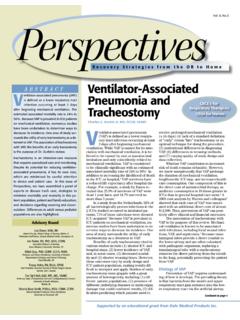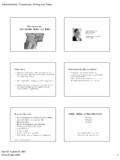Transcription of TRACHEOSTOMY STOMA CARE - Austin TRAMS
1 CLINICAL PROCEDURETRACHEOSTOMY STOMA CARES taff this document applies to:Medical staff, Nurses and Physiotherapists on all campuses including ICU State any related Austin Health policies, procedures or guidelines: Patient Identification Management of patients with TRACHEOSTOMY at Austin Health Mandatory TRACHEOSTOMY Equipment TRACHEOSTOMY e-learning package TRACHEOSTOMY STOMA care Planned TRACHEOSTOMY Decannulation Procedure Emergency response to Accidental Decannulation Aseptic Technique TRACHEOSTOMY Related Bleeding (policy pending 2014)Who is authorised to perform this procedure? All members of medical and nursing staff Physiotherapists working within their scope of practiceDefinition:The care involved with suture removal, assessing and cleaning a TRACHEOSTOMY STOMA including changing the TRACHEOSTOMY dressing and tapes Clinical Alert: A bleeding or pulsating TRACHEOSTOMY could represent a pending emergency and advice must be sought immediately from the TRAMS team (pg 1291) or treating unit.
2 Please see the TRACHEOSTOMY related bleeding policy for the urgent action required. If in doubt, place a MET call/MER call/Code Blue Changing a TRACHEOSTOMY tape is a two person procedure to avoid loss of airway Movement of the TRACHEOSTOMY tube within the trachea during this procedure may cause irritation and coughing In patients who have had microvascular free flap surgery the TRACHEOSTOMY tube will be sutured in place. Do not use TRACHEOSTOMY tapes or ties on these patients as these items may compromise the vascular supply to the flap. Rationale:To maintain skin integrity and prevent complications around TRACHEOSTOMY complete a comprehensive STOMA assessmentExpected Outcome: Skin integrity around the STOMA is : This Document has been developed for Austin Health use and has been specifically designed for Austin Health circumstances.
3 The TRACHEOSTOMY STOMA is clean and free of infection. The TRACHEOSTOMY tube is secured STOMA assessment is comprehensive and management appropriate Surgically inserted TRACHEOSTOMY STOMA sutures are removed within 7-10 days Equipment: Dressing pack Sterile Sodium Chloride Manufacturer pre Y cut dressing (non woven gauze, Exu-dry , foam or as directed by TRAMS or medical unit) Waste bag Non-sterile gloves TRACHEOSTOMY Velcro tape Safety goggles or eye wear Include stitch cutter if removing STOMA sutures Procedure: This is a two-person procedure. Correct patient identification performed Prepare the patient ensuring privacy and comfort. Position the patient with his/her neck slightly extended.
4 Wash hands and use debug, don non sterile gloves and PPE Set up dressing trolley. One person holds the TRACHEOSTOMY tube whilst the second person removes the soiled tapes and dressing. Discard into waste disposal bag immediately. Assess the TRACHEOSTOMY STOMA for signs of trauma, bleeding, pressure area, infection, inflammation or pulsation. Contact TRAMS (pg 1291) or medical unit for advice if any of the above symptoms noted. Clean STOMA with normal saline soaked gauze by wiping from centre of STOMA outwards and then discard. Place dressing under flange opening should be at the top. Secure the TRACHEOSTOMY tube with Velcro TRACHEOSTOMY tapes. The correct tightness of the TRACHEOSTOMY tape is checked by ensuring only one to two fingers can fit between the tapes and the neck.
5 Dispose of used/soiled : There may be several types of sutures at the STOMA site. It is essential to ascertain reason for insertion and consult TRAMS (pg 1291) or the medical unit responsible for inserting TRACHEOSTOMY tube prior to removal of any sutures. Disclaimer: This Document has been developed for Austin Health use and has been specifically designed for Austin Health circumstances. HEAD AND NECK SURGERY SUTURES:The TRACHEOSTOMY is secured by sutures through the flange Ensure sutures remain intact check at commencement of each shift Clean with normal saline soaked gauze TDS and leave exposed Consult parent unit when to removeSURGICALLY INSERTED TRACHEOSTOMY STOMA SUTURESS toma sutures are usually 2 x black standard sutures at the horizontal STOMA incision and 2 x blue stay sutures taped to the chest Sutures should be removed within 7-10 days post initial insertion of tracheostomyTo remove blue stay sutures.
6 Separate threads and cut one as close to the STOMA as possible Pull the longer thread through and remove from tissue Repeat process with second blue stay sutureTo remove black sutures at the horizontal incision (under flange): Secure knot with forceps Apply tension and free knot from tissue to expose sutureDisclaimer: This Document has been developed for Austin Health use and has been specifically designed for Austin Health circumstances. Cut one side of suture below knot Pull through and remove from tissue Repeat process with second black suture Post Procedure:Document in patient medical file: STOMA integrity, signs of infection, presence of granulation tissue Any bleeding from STOMA .
7 STOMA care regime Dressing utilisedNotify TRAMS (page 1291), treating unit or place MET call (depending on patient status) if any: Bleeding PulsationAuthor/Contributors:Kristy McMurray TRAMS Clinical Nurse ConsultantQuevy Vu, TRAMS Clinical Nurse ConsultantIn consultation with: TRAMS teamJohn Rogan NUM ICU;Carmel Taylor ICU Nurse Consultant; Dr Steve Warrillow, Deputy Director ICU, TRAMS ICU Liaison Legislation/References/Supporting Documents: Brunker, C., Dawson, D., Kourteli, E., Maistry, N., Moore, M., Wilkinson, O., Kelly, G. (2012). Guidelines for the care of patients with trachestomy tubes (2012 ed.). Baulkum Hills (Smiths Medical): St George s Healthcare NHS Trust. Bryant, Nix, (2012) Acute & chronic wounds: current management concepts (4th ed.)
8 St Louis, Missouri: Elsevier MosbyIntensive care Society Standards (2011) Standards of the care of adult patients with a temporary TRACHEOSTOMY . Intensive care Society CouncilMorris, ,& Afifi, (Eds.). (2010). Tracheostomies:The complete guide. New York: Springer Publishing CompanyMyers, & Johnson, (2008) TRACHEOSTOMY : airway management, communication and swallowing.(2nd ed.). San Diego: Pleral PublishingUlcer and wound management Expert Group. (2012) Therapeutic guidelines: ulcer and wound management. Melbourne: Therapeutic Guidelines LimitedAuthorised/Endorsed by:Clinical Nursing Standards CommitteeDr Graeme Hart, Director ICU, Dr Mark Howard Director VRSS, Sue Berney, Director Physiotherapy Disclaimer: This Document has been developed for Austin Health use and has been specifically designed for Austin Health circumstances.
9 Primary Person/Department Responsible for Document: TRACHEOSTOMY Review and Management Service ( TRAMS ).Disclaimer: This Document has been developed for Austin Health use and has been specifically designed for Austin Health circumstances.
